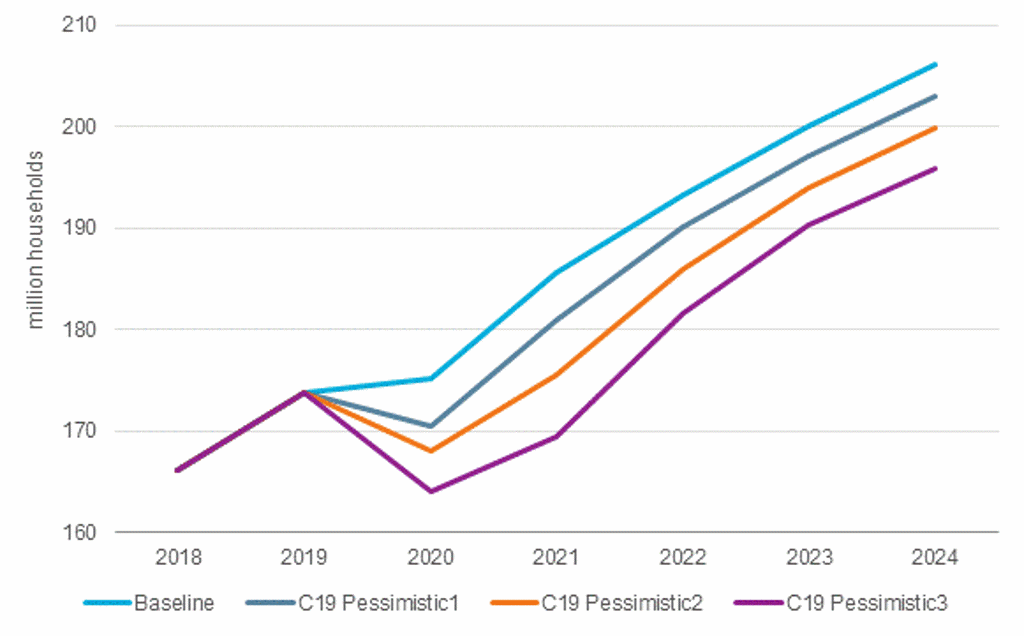With China making up nearly half of emerging and developing countries’ middle class (comprising of households with an annual disposable income of US$15,000-45,000), insights into the country’s substantial middle-income segment amidst the Coronavirus (COVID-19) pandemic is important for global companies doing business not only in China but also across emerging and developing countries, because such insights provide a general indication of how emerging markets’ middle class consumption habits are going to change as a result of COVID-19. For China, Euromonitor International forecasts that spending by the Chinese middle class will fall in 2020 despite continued expansion of this segment overall.
Middle class spending shifts to essentials in the baseline scenario
In our baseline scenario, Euromonitor International forecasts that China’s middle class will expand by 0.8% in 2020 to reach 175 million households by the end of the year. Although the Chinese middle class will continue to expand, this rate of growth is very modest by China’s standard, as the pandemic adversely impacts the country’s economic activity and middle class households’ income gains. Prior to COVID-19, the middle class in China expanded by a more representative rate of 4.5% year-on-year in 2019.
Total middle class spending is set to fall by 1.2% year-on-year in real terms in 2020, despite the 0.8% rise in the number of middle class households. On a per-household basis, the spending decline will be even steeper at 1.9% year-on-year in real terms. Although such declines are relatively modest compared to many developed countries, they will dent the confidence of Chinese middle class consumers, who have been accustomed to decades of uninterrupted income and spending growth.
In 2020, the average middle class household can expect to see its food spend to rise by 16.6% in real terms, as COVID-19 sends food prices soaring and people also eat at home more. Discretionary spending by the middle class will decline as a result, from 57.9% of the household budget in 2019 to 52.7% in 2020.
Annual Real Change in Spending per Middle Class Household in China: 2020
Source: Euromonitor International’s Consumer Spending by Income Bands Model. Note: Data are forecast
Three scenarios of a more severe outbreak
While the baseline scenario is the most probable scenario, Euromonitor International has created three further scenarios of a more severe outbreak, which would see China’s middle-class income and expenditure be dented more significantly:
• In the C19 Pessimistic1 scenario, which is slightly more pessimistic than the baseline scenario, and where there is a major second global pandemic wave in 2020, followed by a possible third wave in 2021, the number of middle-class households in China will fall by 1.9%, while total spending by the segment as a whole will shrink by 4.0% in real terms in 2020.
• In the C19 Pessimistic2 scenario, there is a more significant second global pandemic wave in 2020 compared to the Pessimistic1 scenario, followed by a third and possible fourth wave in 2021, and large scale distribution of an effective COVID-19 vaccine or treatment is delayed into 2022-2023. The number of middle-class households is set to decline by 3.2% and their total spending will fall by 5.5% year-on-year in real terms in 2020.
• In the worst scenario (C19 Pessimistic3), the picture is much more sombre where there are 3-5 global pandemic waves in 2020-2022 and large scale distribution of an effective COVID-19 vaccine or treatment is delayed into 2022-2023. In this scenario, the number of middle-class households in China will fall by 5.5% in 2020 and their total spending will decline by a huge 8.0% year on year in real terms (equivalent to spending cutbacks worth a massive US$216 billion).
Number of Households with an Annual Disposable Income of USD15,000-45,000 in China: 2018-2024
Source: Euromonitor International’s Consumer Spending by Income Bands Model. Note: Data for 2020-2024 are forecast.
Changing values and consumption habits
When asked in January-February 2020 at the onset of the Coronavirus crisis, an overwhelming 80.1% of middle-class respondents to Euromonitor’s Lifestyles Survey in China stated that they find themselves looking for ways to simplify their lives. COVID-19 will amplify this sentiment as consumers are yet to feel safe going about shopping and eating out, as usual, household disposable incomes are falling, and consumer confidence is dented.
Already, Chinese middle-class consumers have started to reassess their values and embrace new consumption habits. Whereas buying used goods was previously stigmatised as it was regarded as a consumption behaviour associated with poverty and low quality, the hashtag #ditchyourstuff has recently trended on Chinese social media and the country has also seen a surge in transactions for second-hand goods. Consequently, Alibaba Group’s Idle Fish (Xianyu) – a used-goods platform modelled after its Taobao marketplace – has enjoyed booming business ever since the COVID-19 outbreak.
In March 2020, its number of newly registered users grew by 40% year-on-year, with daily transactions reaching an all-time high. Businesses, therefore, must act now to adapt to and capitalise on, the shift in consumers’ attitudes away from conspicuous consumption towards acquiring less and accepting second-hand goods.


